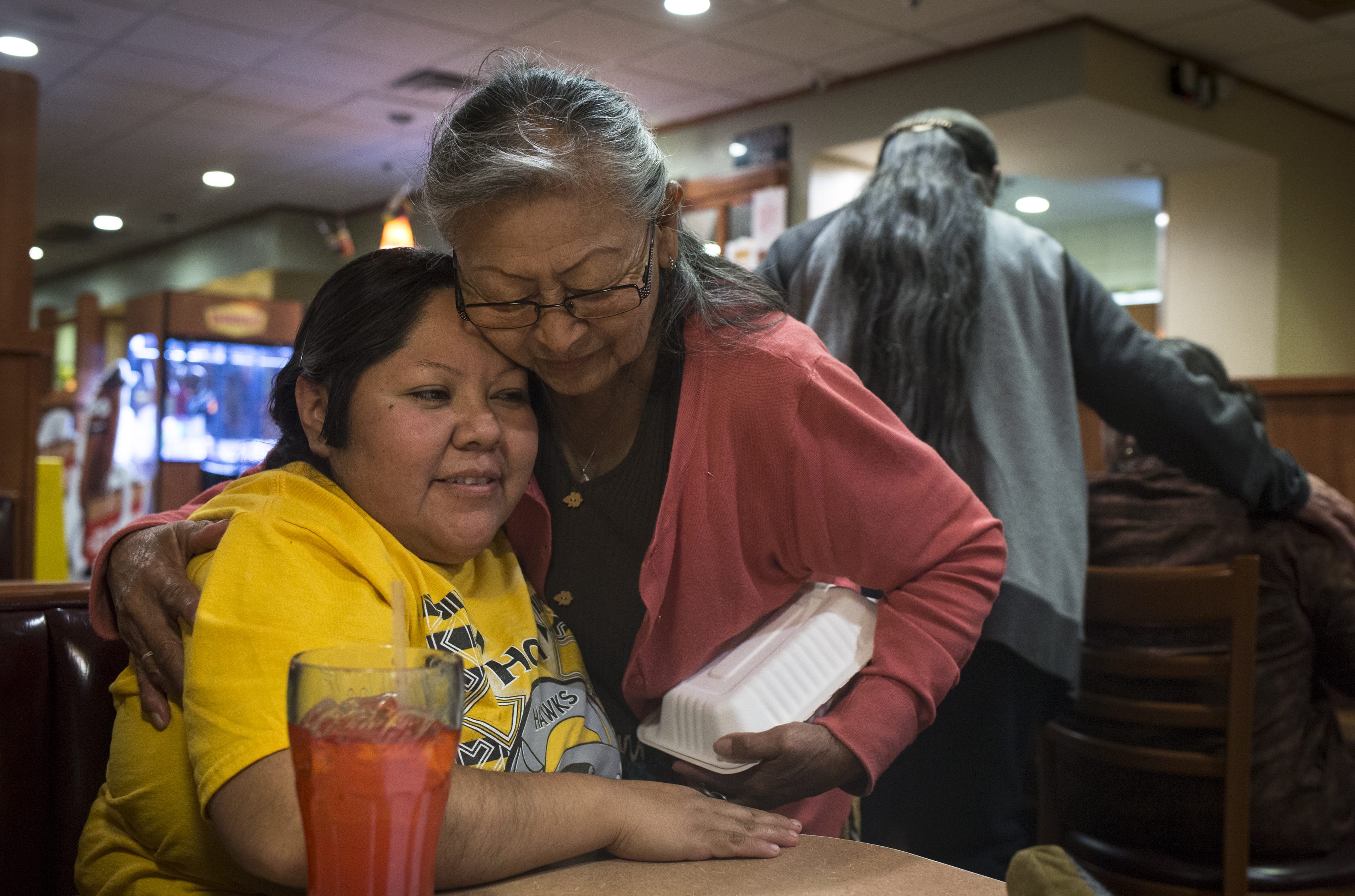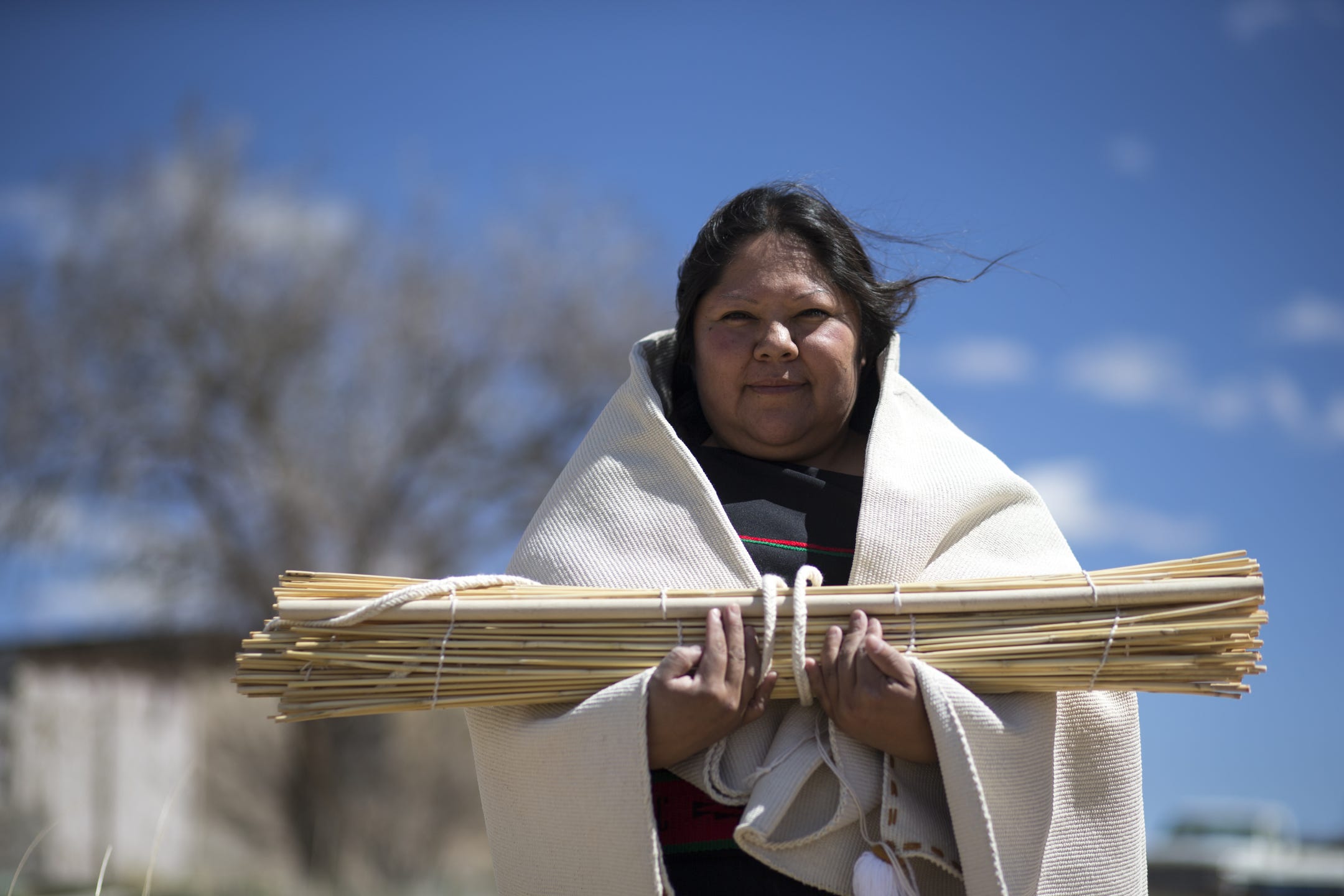
"Askwali," one woman shouts.
Her words trigger a chain reaction inside the house as an assembly line of women shouts the same phrase while moving wedding gifts into a back room.
"Askwali" is how Hopi women say thank you in their Native language. For men, it's "kwakwhay."
These words fill the air every day for 10 days as dozens of family members of Kara Honanie and Lester Honanveama work together to host a traditional Hopi wedding.
"This is one of the ceremonies that we do," says Watson Honanie, father of the bride. "This is all Hopi history."
The bride, Kara, is from Hotevilla and the groom, Lester, is from Moenkopi. Both villages are on the Hopi Nation in the northeastern part of Arizona.
The couple has been together for 15 years, and Kara says she never considered getting married in a Western way; she always knew she'd have a traditional Hopi wedding.
"It's a lifetime commitment, memorable and it was nice to have family gathering from the beginning to the end," she adds. "We all worked hard, and did what we could."
The Honanie family invited The Arizona Republic to witness the 10-day event, normally a very private affair, and share their traditions in text and photo.
The Hopi Tribe is a sovereign nation with more than 13,000 citizens whose reservation occupies part of Coconino and Navajo counties, and it is made up of 12 villages on three mesas, according to the tribe's website.
Having a traditional Hopi wedding is not easy. It takes a lot of work from both sides of the family and their relatives.
"It's something that you should be proud of for the rest of your life," says Sarah Honanie, mother of the bride. "This is a real true Hopi way of life, this marriage. Nowadays there is not a lot of this. I know 10 years from now it'll be different."
The wedding date is picked by the bride's family. It took the Honanie family two years to plan because they need to give themselves enough time to prepare all the corn, gifts and food needed for the wedding.
Preparation started when the Honanie family planted blue, white and sweet corn in their fields. They then harvested hundreds of corn leaves, corn husks and ears of corn to be stored away for the wedding.
"You have to have corn to get married in Hopi," Sarah says. "If you don't have corn, I don't know how you'll do it."
The corn leaves and corn husks are used to make the traditional Hopi sweet blue corn bread called somiviki. The bread is made using blue corn, juniper ashes, sugar and boiling water. The dough is then rolled in the leaves or husk and steamed.

From August to early December of 2018, the Honanie family prepped the corn for the wedding. Corn is shelled, cleaned, crushed and cooked, all by hand. Afterward, they take the cooked corn to be ground at a mill.
The cornmeal is used for cooking and given as a gift to the groom's family in several 20-gallon tin trash cans filled to the top.
"Everything is from the fields and with your hands. It's hard work to prepare all this stuff," Sarah says. "Everything is done with prayers."
After the corn, the piki bread is made. Piki bread is a paper-thin blue corn bread cooked over a fire using a stone cooktop. Every day, from December to mid-February, they make piki bread. The final product fills more than 85 medium-sized cardboard boxes.
By the beginning of March, they are ready.
The traditional teachings used by the Honanie family at the wedding have been passed down for generations. When Sarah got married, her mother told her to keep notes, so she'd be ready for both of her daughters' weddings.
"This is all from my mom's history," she says. "It's a lot of work. It's been handed down generation to generation."
The wedding is planned for March 19 to March 28, because Sarah's wedding was also in March. Her other daughter was married in March 2014.
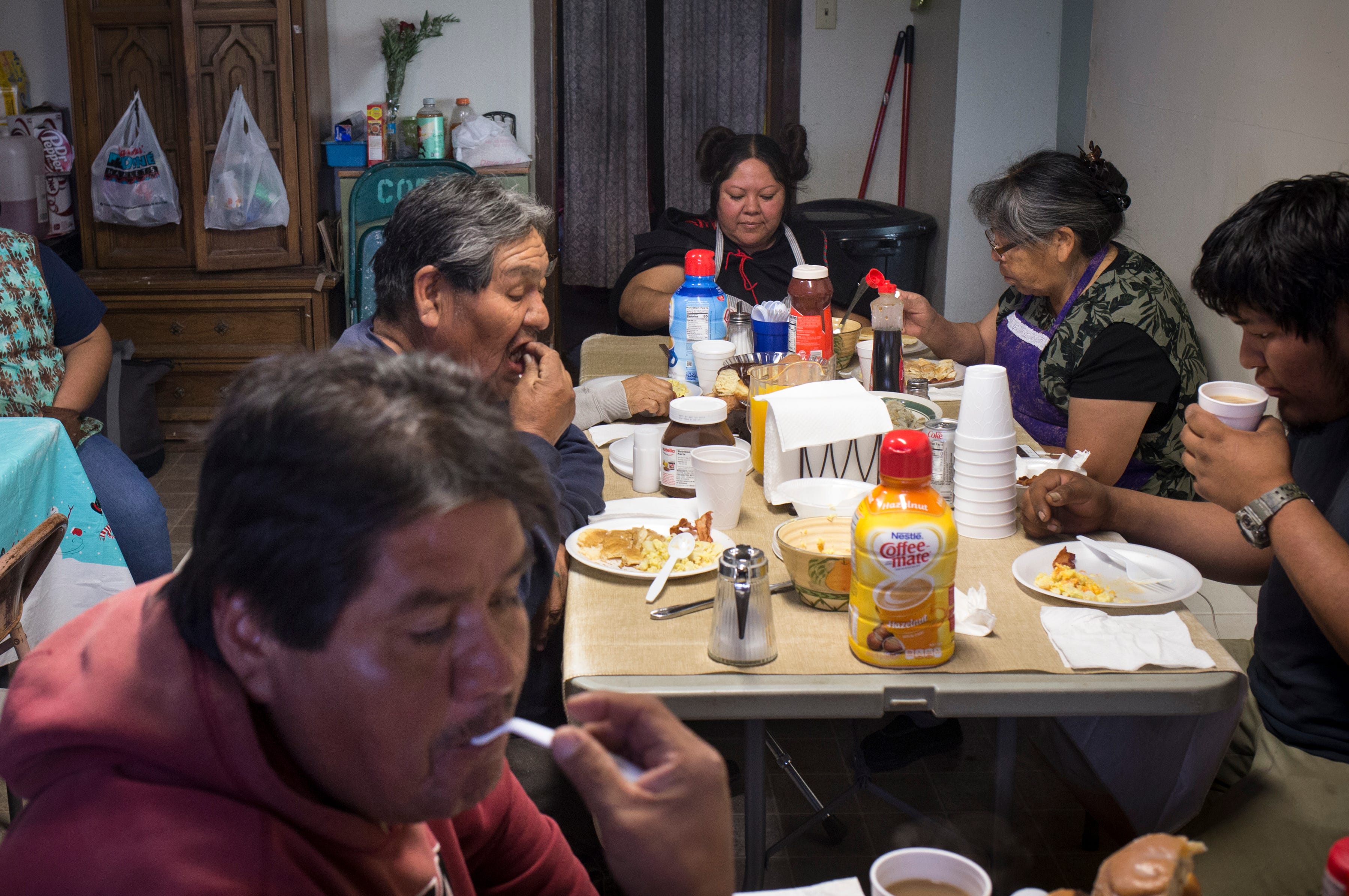
On the morning of March 19, Kara gets ready to travel the 46 miles from her home in Hotevilla to Moenkopi, where she will stay with her in-laws for several days.
Everything the bride wears during her wedding is borrowed. Kara dons her sister's wedding manta, a black one-shoulder textile dress, as well as three capes, provided by her mom and aunts.
This is all from my mom's history. It's a lot of work. It's been handed down generation to generation.
Her hair is combed by her aunts and fixed into the Hopi butterfly whorl hairstyle, two large buns twisted up on each side, using her mother's hair ties made out of black sheep wool. After she's ready, her uncles give her a pep talk and offer cornmeal for encouragement.
"We all did our share and then she was led out the door with cornmeal," Sarah says.
Kara travels to her in-law's house in Moenkopi, where she stays for nine days.
The length of the wedding varies, depending on how long it takes for the bride's white wedding robes to be completed. One large and one medium robe is handwoven by the uncles of the groom's family. Sarah's wedding lasted nearly a month.
Weaving starts on the first day of the wedding, when the bride arrives at her in-law's house, and she stays until they're completed, so she can wear them on her return journey home.
It's the groom's responsibility to help gather the materials needed for the robe and the reeds for the wedding suitcase she'll use to carry the robe. They are both made inside the Kiva, a traditional structure built underground and used for ceremonies by the Hopi people.
The bride is responsible for grinding corn and preparing meals for the family and relatives as she waits for the weaving to be completed. The corn grinding is done by hand, using two grinding stones.
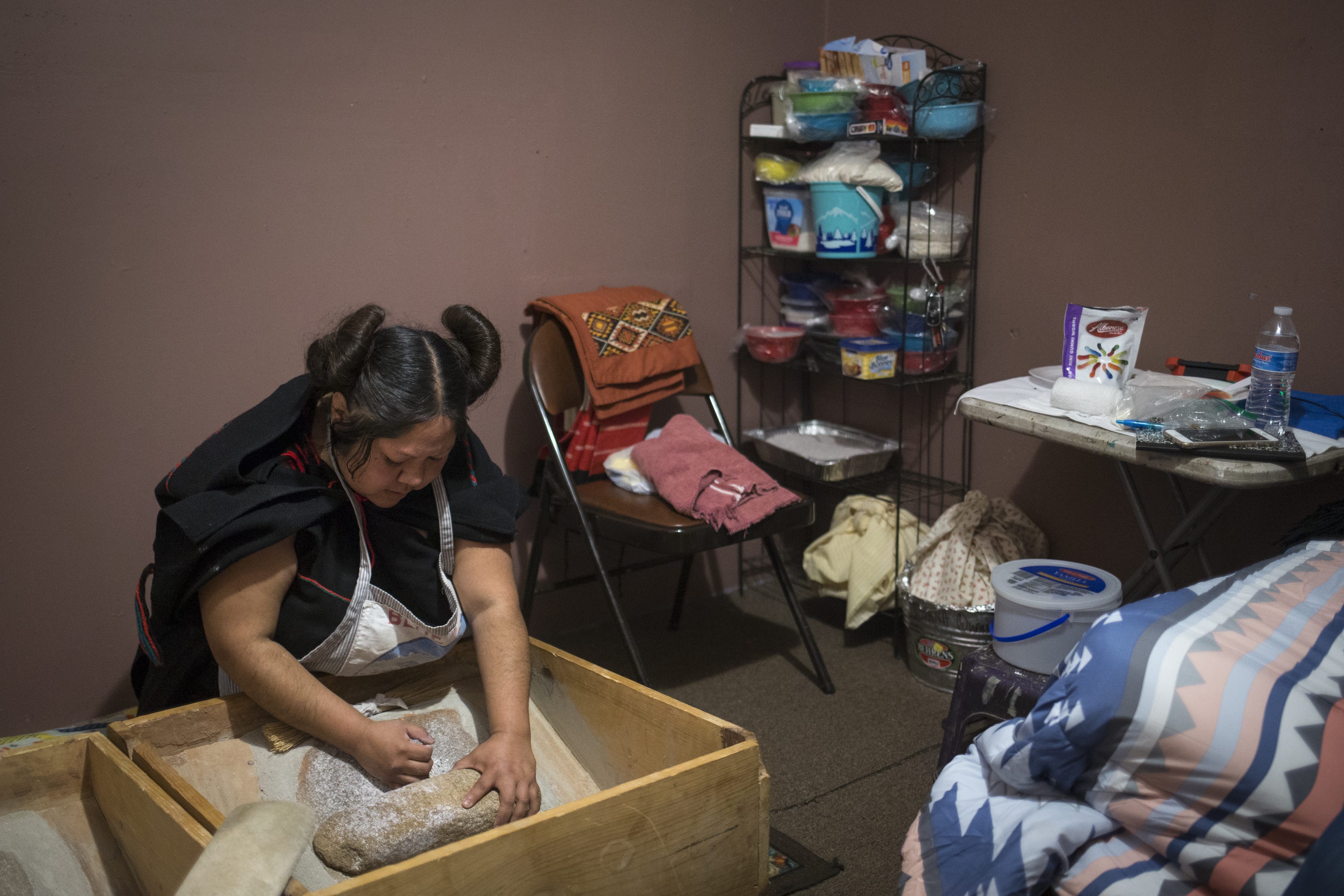
On the fourth day, people gather at the groom's family home.
By the end of the day, the house will have mud splattered across the front door and muddy handprints will be smeared across the windows. No one is bothered by the muddy mess because many had a hand in it.
This is how it starts.
Walking behind a Hopi police car, dozens of the groom's female relatives march up the dirt road with determination.
Over the wailing of the police siren, the women can be heard whooping or yelling. A few even shout, "Run, Kara!" as they walk.
Many wear baseball caps with feathers and paper fringe tied to them. Some carry buckets full of mud, and others hold up cardboard signs.

"Kara did not shell her own corn. Did not wash her corn. Did not make her own kwiptosi. So, go home!" one reads. Kwiptosi is a traditional Hopi dish made from white corn.
Piled together in front of the house, the women from the groom's family taunt the approaching women. Then, the first heap of mud is thrown, and the women scream as they are attacked with more mud. The air quickly fills with shrieks, laughter and mud.
It's a teasing and playful part of a traditional Hopi wedding that shows the mother-in-law and the rest of the family that they care for Lester, Sarah says. It's usually a fight between the women from the groom's family and other relatives.
The fight is all in good fun, but that doesn't stop the women from aggressively covering people with mud. They stick their hand in the bucket of mud and shove it into the face of their targets. When they run out of the mud in their buckets, they scrape it from their face or hair and throw it.
"You too," one lady yells as she shoves mud in another's face.
During the fight, most of the men watch from the sidelines and cheer, including the groom. That was until one of the women from the mud fighting crowd spots him; he is quickly surrounded.
"Hey. Hey," the other men say as the woman start to attack Lester with mud. Lester only laughs and smiles, making no attempt to stop them. His family pushes the women back for him.
"You guys look ridiculous," one man yells at the women mud fighting.
"That's not what Lester says," a woman retorts, causing everyone to laugh.
Lester's family can't hold off the group of women for long. Soon he is surrounded once again by several women, each of them shoving their hand forward to cover him with mud.
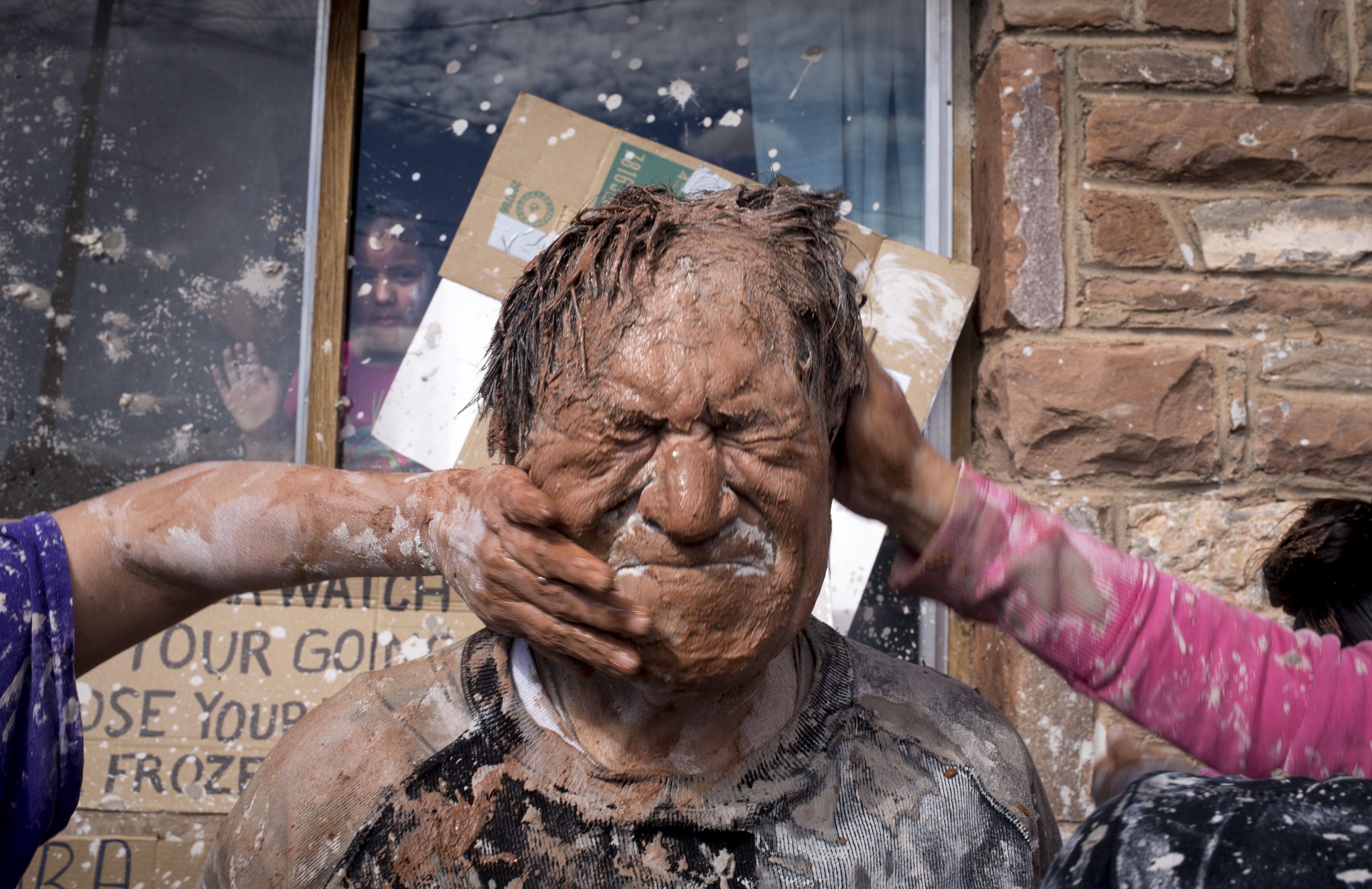
When the excitement dies down, the crowd separates and a howling erupts from the women in the groom's family who stand in front of the house. The group of women walking back down the road responds with a growl, bringing the mud fight to an end.
There is visible evidence of the fight afterward — mud cakes the women's hair and splatters across their jeans. A slew of cardboard signs lean against the house and litter the ground with words all aimed at the bride.
"Nothin' messes up your Friday like finding out Kara's going to be your mewii," one sign reads. Mewii is the Hopi word for a female in-law. More teasing from the aunties in the groom's family.
The family can't wash the mud off the house after the fight. They have to rely on the rain to do it for them.
Later in the evening, after everyone cleans off the mud, they gather in front of the house and watch a line of vehicles slowly drive up the mesa.
It's a tradition for the bride's family to travel from their village to the groom's home with food and gifts. The Honanie family drove 46 miles with trucks full of cornmeal, Blue Bird flour, pastries and piki bread.
The amount given is determined by Gloria Phillips, the groom's mother, and it will be handed out to people who helped during the wedding. The groom's family keeps a detailed list of everyone who donated and helped. Everyone on that list receives some of the food and gifts.
"We only make it and take it," Sarah says.
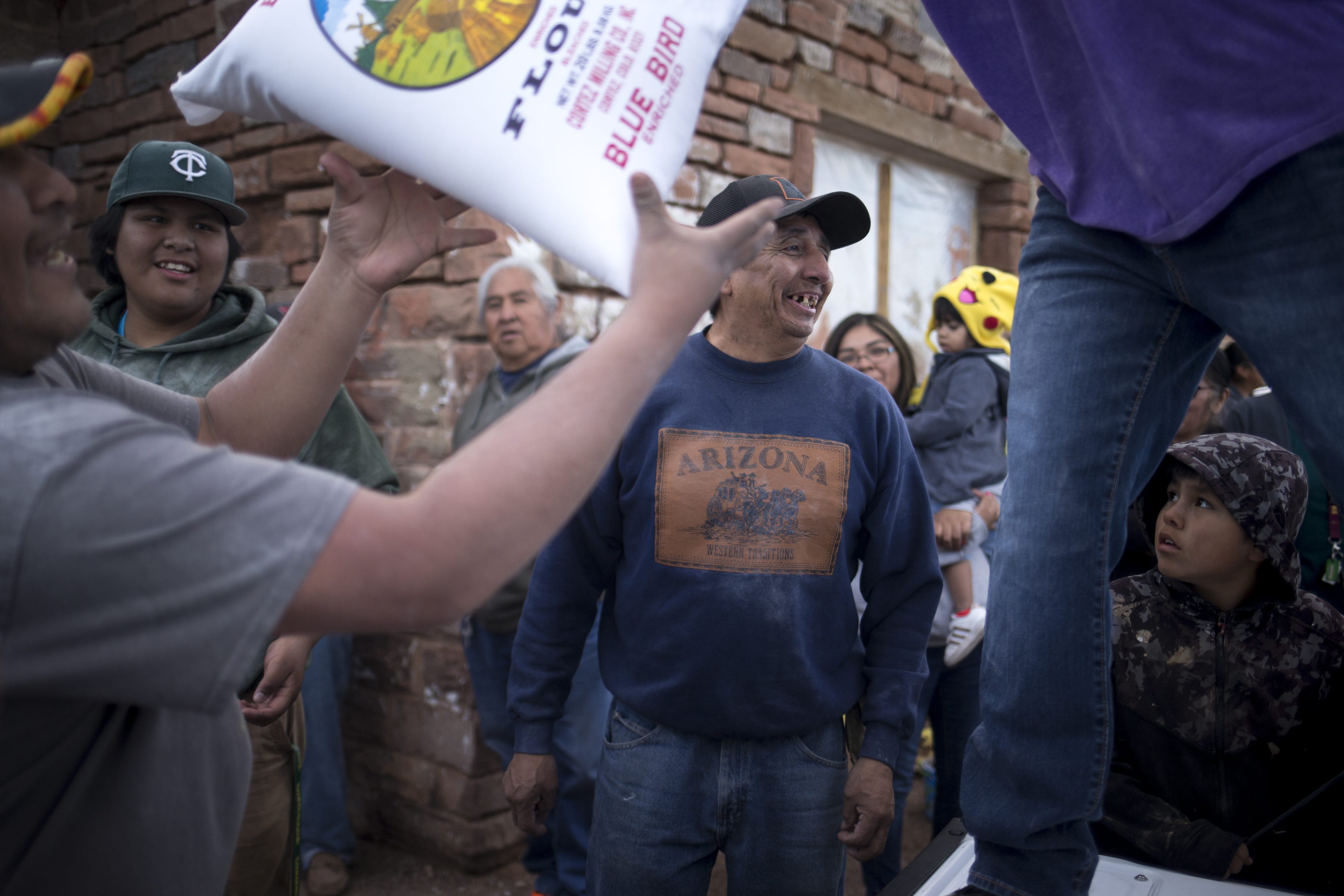
The vehicles stop down the road from the groom's family home. This is where Sarah, wrapped in a dark blue shawl, will quietly lead a chain of women up the dirt road, each one holding a cardboard box full of piki bread.
Halfway up the road, she's met by the linked arms of the aunties from the mud fight blocking them from moving forward. It's another form of teasing.
"This is a checkpoint. Open up your boxes," a lady says.
Sarah Honanie stops briefly as the women gather in front of her. She inches forward, causing the women to laugh and shuffle to stay in formation. She moves forward again.
"Get away," Sarah says before moving past them with the line of women behind her.
As she approaches the house, Sarah and the women are met with a resounding "askwali" and "kwakwhay."
Sarah is greeted by Gloria at the door and led into the house. More women inside shout "askwali" as each box goes inside. Sixty-eight cardboard boxes, the size of those filled with produce at a supermarket, of piki bread aregiven to the family.
The men gather in front of the house and wave in one vehicle at a time to unload. They form a work line and move the goods inside the house. Nearly 30 vehicles are unloaded.
The Honanie family's contribution brings the day's wedding activities to an end. The family heads inside and shares a meal with all who helped.
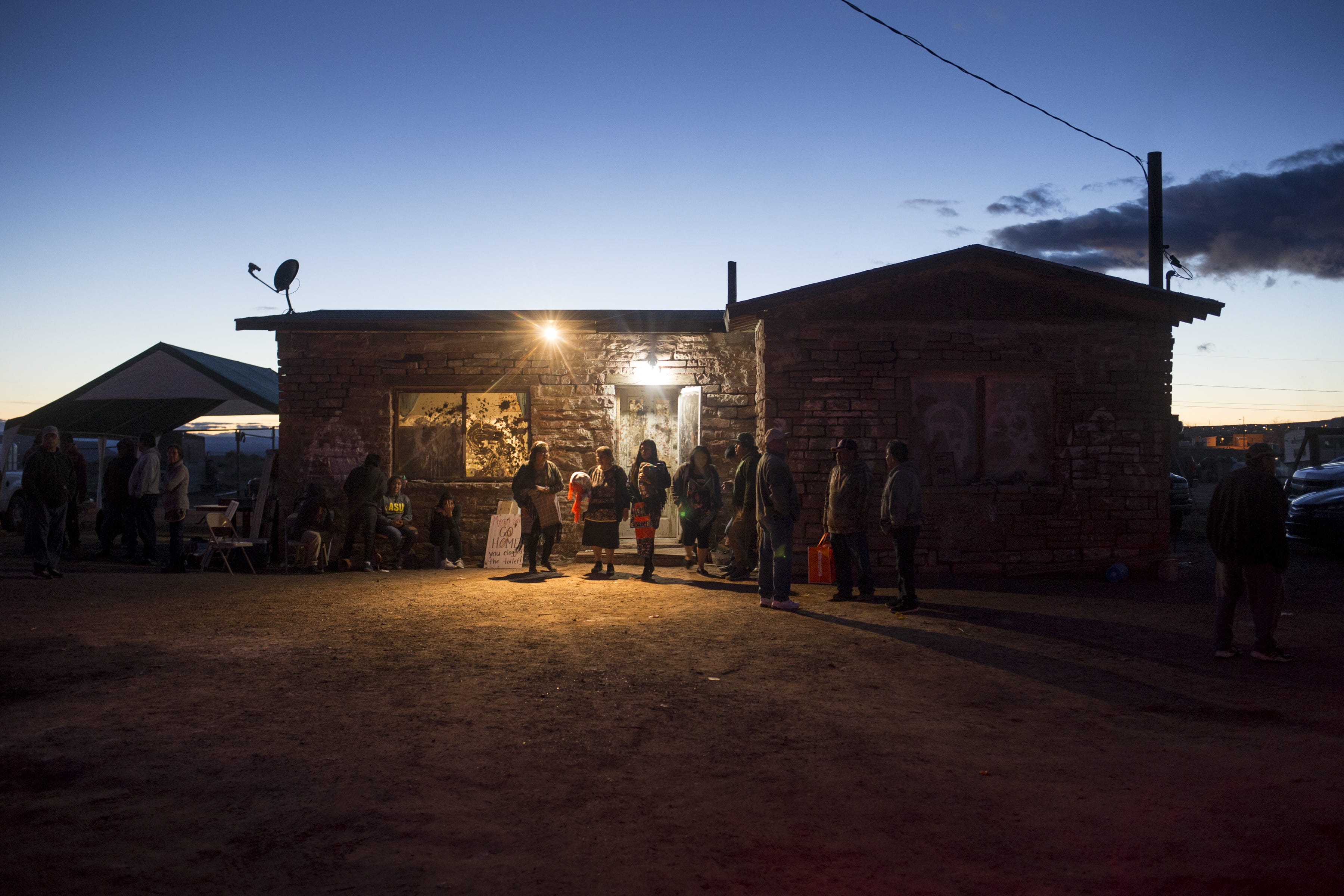
Hours before the sun rises on the fifth day, both mothers get to work in the kitchen. They start ripping up yucca root into two turquoise-colored wash bins on the floor in the middle of the kitchen. The house is quiet as the family works.
The yucca is used to wash the couple's hair. When yucca root is mixed with water it turns into a natural shampoo. Sarah says Hopi people used it in the old days, and the tradition continues.
The bucket is filled a quarter of the way with water and the yucca root is rubbed together to make it soapy. Family members pile into the kitchen area to watch, as others stand in the living room, tiptoeing over each other to see.
"This is supposed to be the very important thing, starting your life as a couple," Watson says. "Washing of the hair is like getting them married."

Kara sits quietly on the chair to the side watching as her mother moves her hands through the water. Her hair is still up in the butterfly whorls. Her mother-in-law starts to take her hair down. This will be the last time Kara wears her hair in the style because it is worn only by unmarried Hopi women.
When the soapy water is ready, the family allows other relatives to add water to the bins. Family members line up with little containers of water they got from the local spring. One by one, they add their own water to the bin as a way of blessing the marriage.
This is where you get bonded, you become the best friend of each other. You wash your hair together, so you'll be together for the rest of your life.
The bride stands barefoot in front of one wash bin, still dressed in her manta, with her hair down and falling past her shoulders. The groom stands next to her on the left, wearing jeans and a T-shirt, his hair just barely reaching his ears. The couple kneels on pillows in front of the bins. When they lean over, Lester's mother washes Kara's hair and Kara's mother washes Lester's hair, as is the custom.
"He became my son, we accepted him as my son," Sarah says. The same goes for Kara; when her mother-in-law washes her hair, she is accepted as her daughter.
The couple's hair is washed for about 20 minutes in silence. Only the sound of the water dripping back into the bin and soft-spoken commands from the mothers is heard throughout the house. Then, the couple's hair is intertwined and washed together, bonding them in marriage and signifying their union as husband and wife.
"This is where you get bonded, you become the best friend of each other," Watson says. "You wash your hair together, so you'll be together for the rest of your life."
For the Hopi people, there is no divorce, he adds. Even in death, they'll still be married.
After the couple's hair is washed together, the mothers invite family members to wash the couple's hair. Relatives line up, scoop up soapy water and put it on the couple's head.
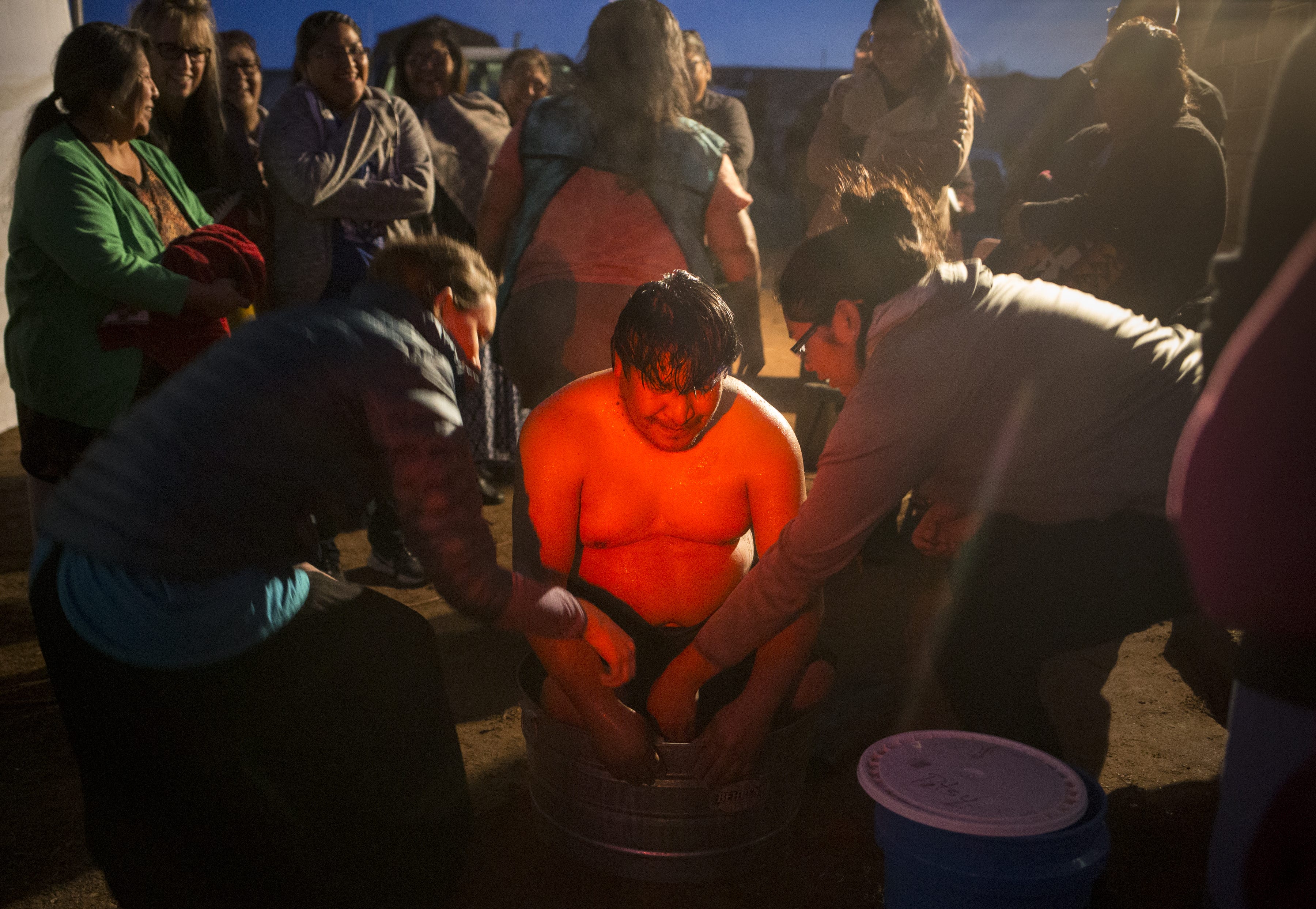
Once the hair washing is done, Sarah takes her son-in-law outside to the back of the house where another wash bin is set up. The sun still has not come up. The street lamp is the only source of light as everyone huddles around the bin.
Lester undresses until he is only wearing a pair of short cuts. He squats down in the wash bin, steam rising off his skin from the hot water as his mother-in-law and the other women bathe him. Kara receives a similar bath inside the house, her mother-in-law washing just her arms and legs.
"She belongs to them forever, just like Lester is always going to belong to us, no matter what," Sarah says.
After the bath, Lester is wrapped in a traditional blanket and taken back into the house. The couple is then walked outside to the front of the house by Lester's mother.
Wrapped in shawls, Lester and Kara stand holding white cornmeal in their right hands and facing east. Their hair still damp, the newly married couple sprinkles white cornmeal toward the rising sun to bless the marriage, bringing the wedding ceremony to an end.
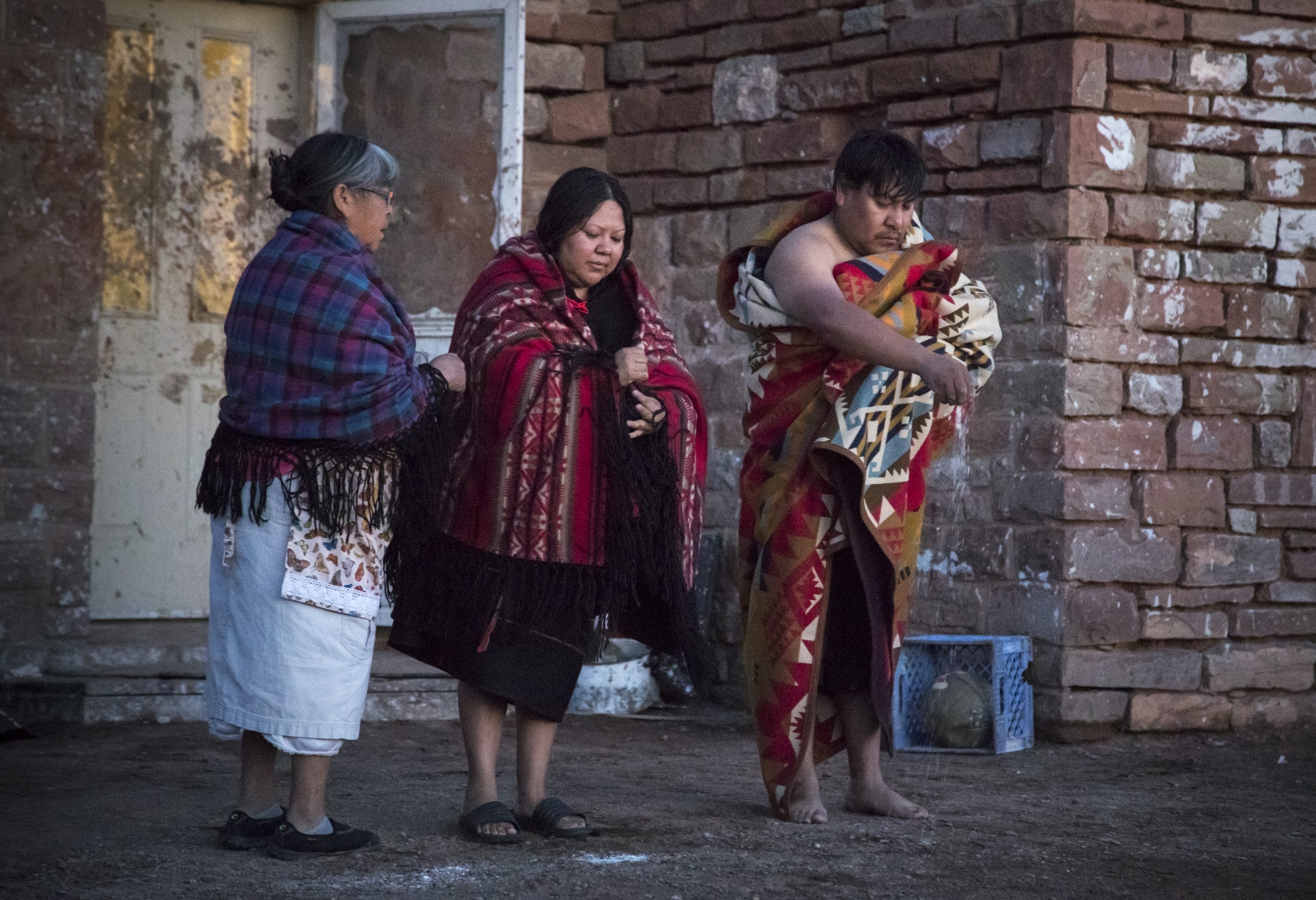
After the wedding ceremony, everyone splits up to work. Inside the house, the women cook, clean, feed guests, and accept and track donations.
Outside, the women set up shop to make somivik. Under a large canopy, tables and benches are lined up on the side as dozens of women work together to make hundreds of pieces of sweet cornbread.
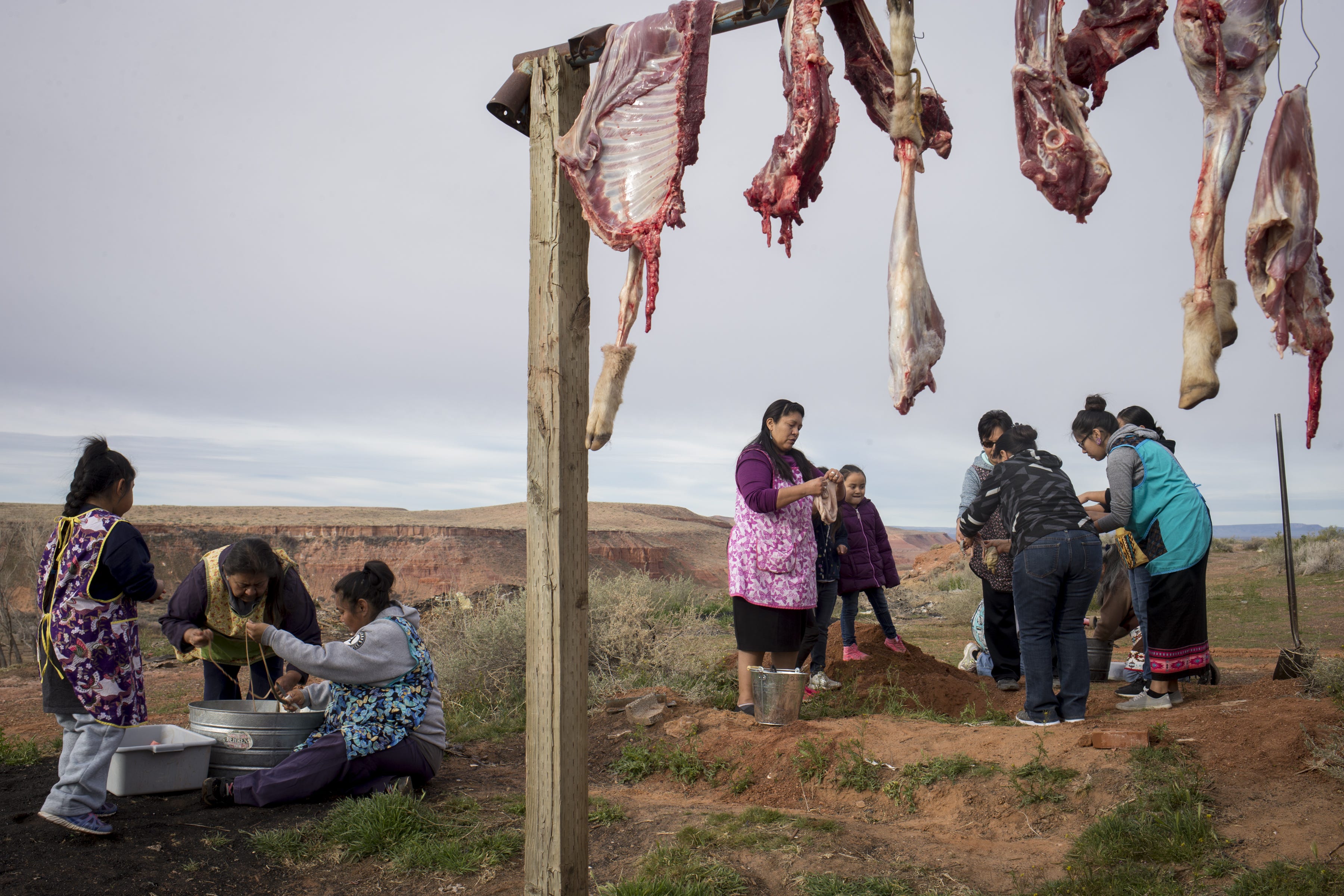
Farther behind the house is the butchering area, with a wooden shed and poles set up to hang the meat. Men gather as one sheep at a time is brought in.
Nine sheep are butchered, and a group of women takes charge of cleaning the guts so they can be cooked.
The house bursts with energy from everyone working, talking, laughing and socializing. Food is served all day, and anyone who steps inside the house is encouraged to eat.
Inside the kitchen, several tables are set up. One table is covered in food, including Hopi delicacies like sheep head and intestines, and pikami, a sweet pudding.
Kara works with her mother-in-law and makes the mixture needed for piki bread. She mixes it in a piki bowl, a traditional Hopi pottery bowl, using a long wooden stick. Once the mixing is complete, she goes to her mother-in-law's piki house.
It is a small, one-room house built directly behind the main house, solely dedicated to cooking piki bread. In the corner, there is a stone cook top set up using bricks and mud.
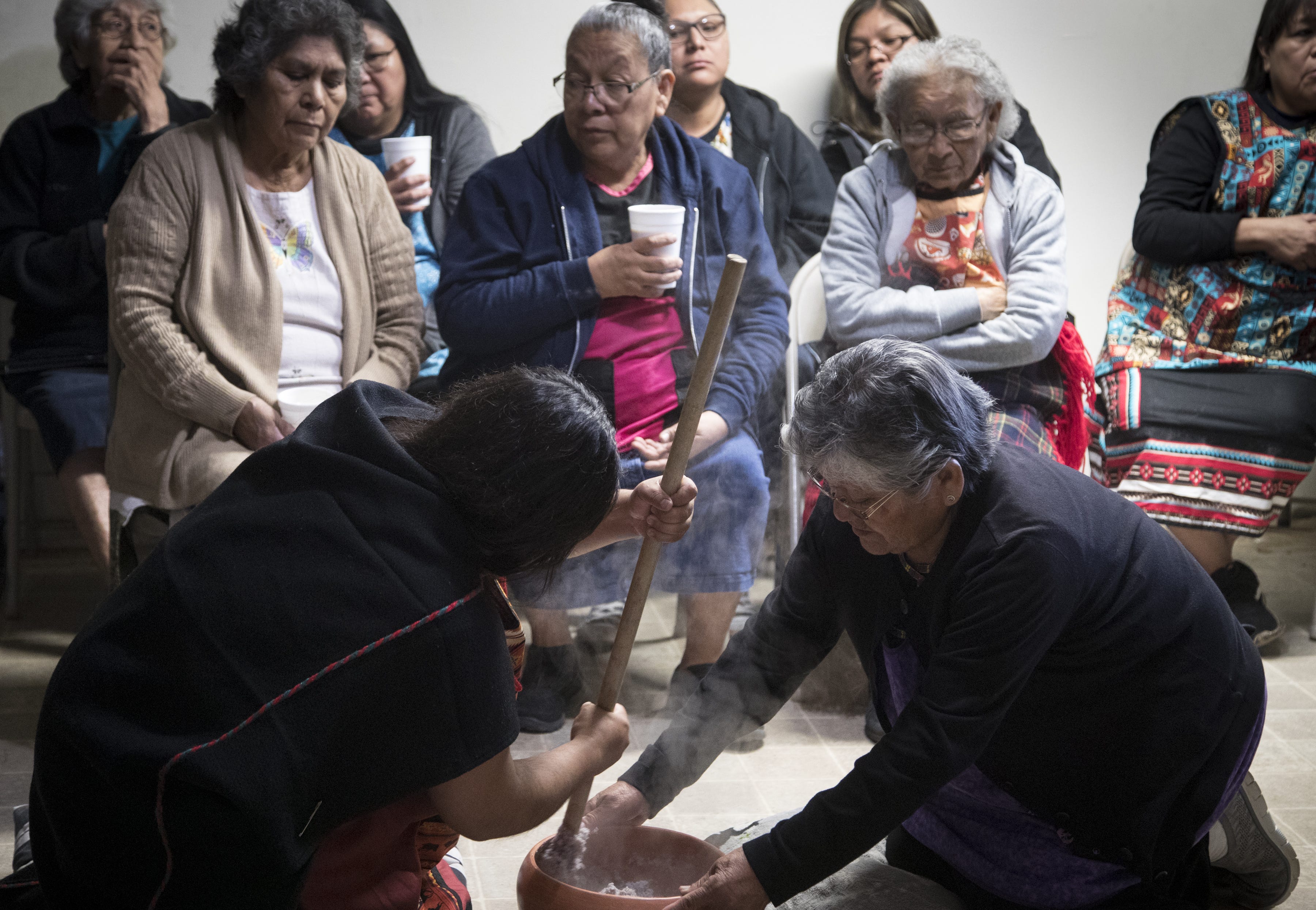
Kara sits in a chair with a towel over her lap. She uses her finger to take a bit of sheep brain from a plastic bowl and spreads it across the stone with a cloth. The brain serves as grease.
Using her right hand, she scoops up some of the wet piki mixture and smears a thin layer across the stone, steam rising with every swipe. She starts from the top and in a swiping motion moves down to the bottom until an even, thin layer is spread on the stone.
Kara's godmother and aunt sit with her as she makes the bread. They offer tips, add more wood to the fire beneath the stone and chat in Hopi.
When it cooks through, Kara peels the ashy blue paperlike bread slowly off the stone, so it won't break. She cooks three layers of the piki bread and stacks them on top of one another before folding it into a square-like shape for a complete piece of piki bread.
Kara takes four pieces inside the main house to be placed on the food table. She then sits down to eat breakfast with her mother-in-law.

Afterward, her mother-in-law fixes her hair. It's fashioned into the Hopi style for married women: hair separated down the middle, tied to the side using yarn. Her sideburns are then cut straight across.
"That's the trademark when they cut the hair on the side," Sarah says. "So, whenever Kara should pass away, down there somewhere they'll see her, recognize her because it's like they branded her. She's always going to belong to that family."
Toward the end of the day, the groom's family starts to hand out gifts to the relatives who helped with the wedding. They separate the cornmeal, sacks of flour and baked goods.
In an assembly line, more than a dozen women stand at the front door of the house to help hand out gifts. One by one, the women are handed sacks of flour with a name on it, a plastic bag with cornmeal and a box full of goodies like pie, cake, cookies and somiviki.
Each woman is given a name of the person to deliver the gifts to and pointed in the general direction of where they might be. They deliver the gifts to vehicles parked around the house or knock on the door of a house down the street. Once the gifts are delivered, they line back up to do it again.

On the clear, sunny morning of March 28, the final day of the wedding, family and relatives gather at the Honanie home in Hotevilla to prepare for Kara's return.
Kara's dad, Watson, and her uncles sit in the living room, chatting as they drink black coffee from small Styrofoam cups. Her mother and aunts are preparing the food and dining area, ready to serve everyone after her return.
"She's coming!" a little girl shouts.
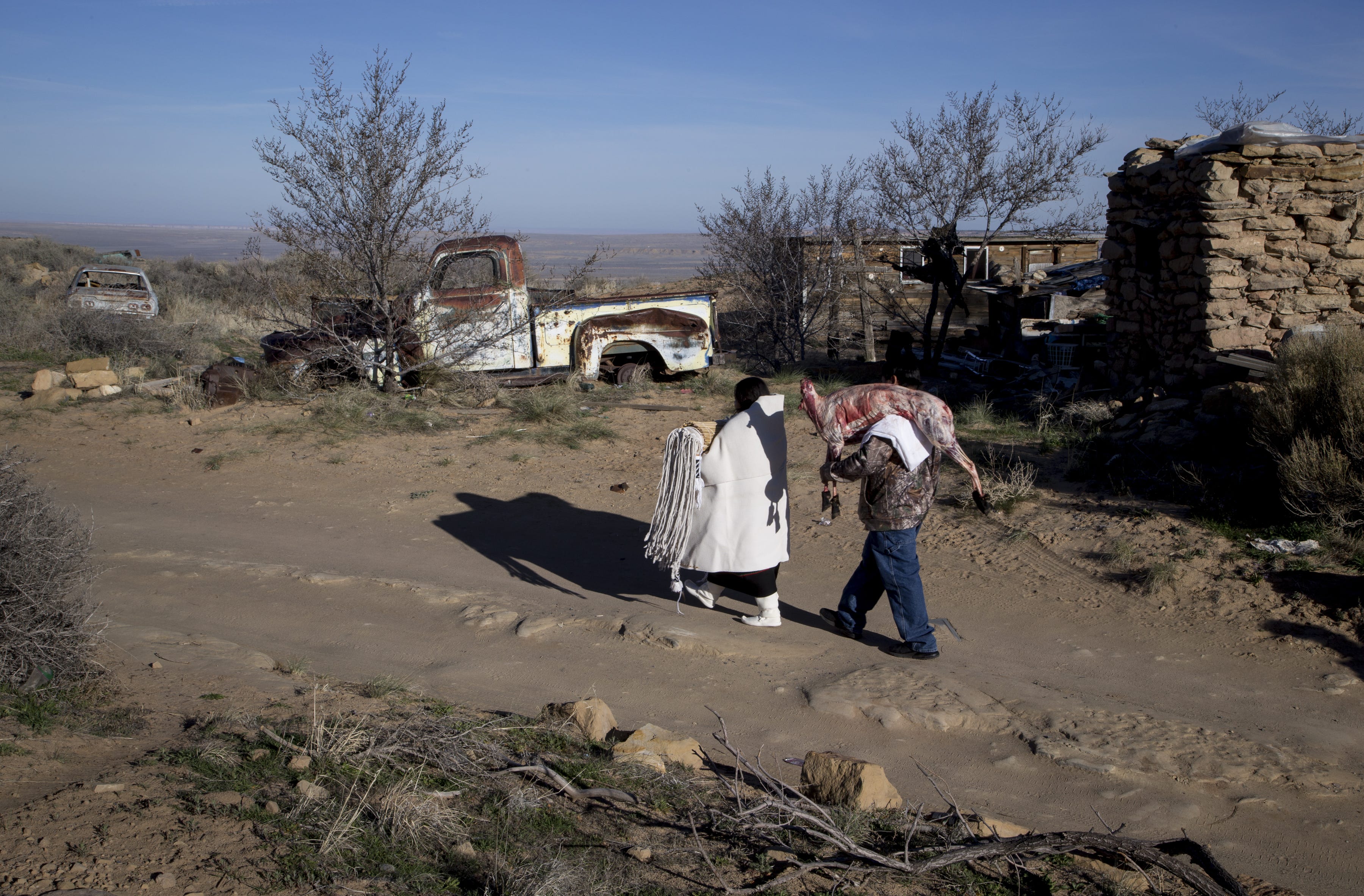
Everyone rushes outside, gathering in front of the house to watch as Kara walks across the village.
Wearing a black manta, covered by a white cape, Kara walks up the dirt road in her white buckskin moccasins holding the traditional bridal suitcase of woven reeds rolled around her wedding sash, a large wedding robe and four pieces of corn for each direction. Yellow corn to the west. Blue corn to the south. Red corn to the east. White corn to the north. The tassels from the sash hang out from the side, each tassel symbolizing rain.
Walking behind her, Lester carries a freshly butchered sheep on his shoulder and is followed by his family carrying gifts and a pot of stew for the Honanie family.
"That's what the in-laws do, they bring meat to your house on every occasion," Sarah says.
Kara's family happily greets her at the house; some take photos, others move back so she can go inside. Kara hands her wedding suitcase to her mother, who passes it to Watson.
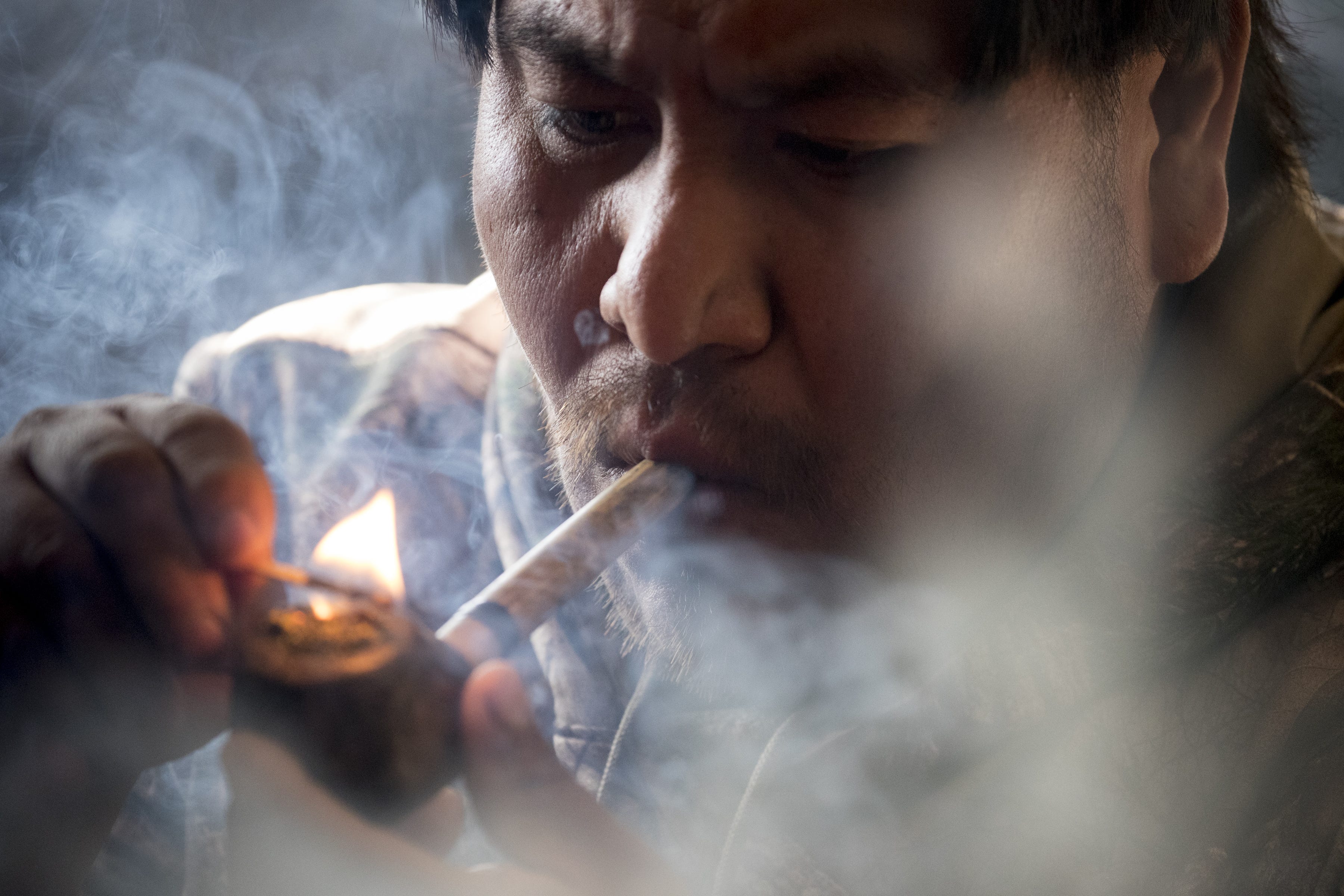
Kara's wedding suitcase stays at her mother's house after the wedding, and it's displayed next to her mother's and sister's cases. "I looked at it and it made me so happy," Sarah says. "We have all the customs that a Hopi woman would have."
Watson takes the suitcase to the corner of the living room and starts to unpack it. He places all its contents on a mound of sand. Watson, Kara's uncles and her husband sit around the stuff and pull out their pipes to smoke mountain tobacco. The men smoke to bless the clothes and corn that were brought in with the suitcase because they are all brand-new.
As white smoke fills the room, the women form a line across the living room and start passing down the gifts given to Kara's family from her in-laws.
The gifts go to a room in the back of the house, and the sacks of Blue Bird flour are stacked along a wall in the living room. Once the gifts are brought in, everyone gathers at the tables set up in the dining and living room to have a feast.
After everyone is done eating, the women start to make the final batch of somiviki for the groom's family.
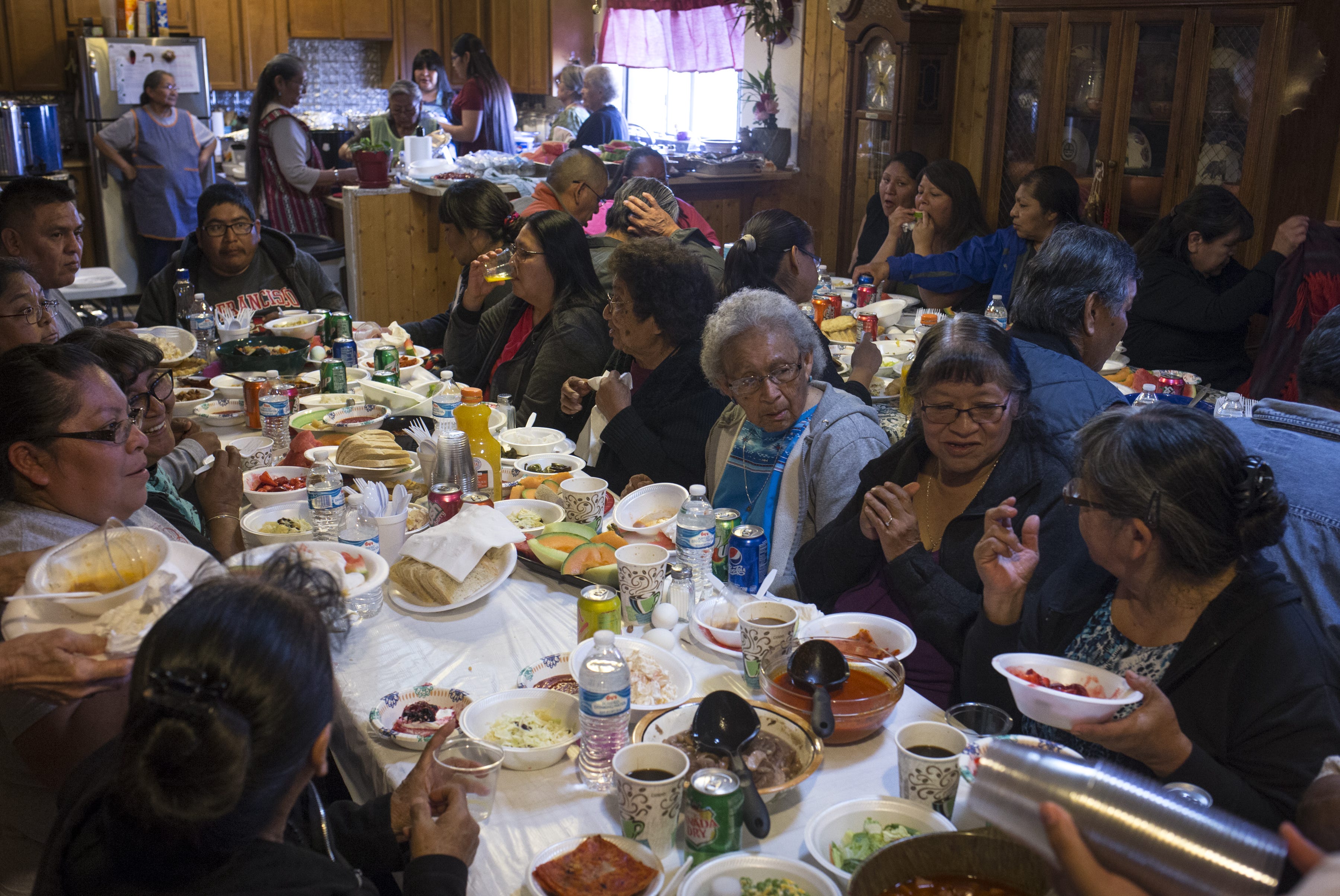
When Kara walked through the village, Sarah said she created a path. Since her daughter intends on remaining in Hotevilla, she said she must return to her in-law's in Moenkopi with somiviki to erase it. The pot they fill is the one the groom's family brought the stew over in.
In between making the somiviki, Kara's female relatives get to try on all her new wedding robes for fun. Sarah says it was a way to show appreciation for all the hard work that was put into making them.
By that evening, Kara and her family put the pot full of freshly made somiviki into the back of the truck. They take the same path back to her mother-in-law's home in Moenkopi. Kara intends on living in Hotevilla with her husband, so this trip erases her earlier path and signifies the end of the wedding.
Reporter Shondiin Silversmith covers Indigenous people and communities in Arizona. Reach her at ssilversmi@arizonarepublic.com and follow her Twitter @DiinSilversmith.
Support local journalism. Subscribe to azcentral.com today.
